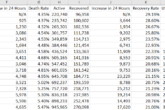The twists and turns of life.
Who could have forecast the inevitability of the unlikely event of COVID-19, a Black Swan, or that such would create an implausible surge in the golf industry that has been struggling for over the past 30 years?
What does the future hold for golf? Harvard economist John Kenneth Galbraith wrote, “There are two kinds of forecasters: those who don’t know and those who don’t know they don’t know.
The problem is self-proclaimed experts on the business of golf, such as me, is that we enjoy free rein with few negative consequences as one’s proclamations tend to be sensational to rise above the din of daily life.
Realizing the folly of such, what are we learning 60 days after most golf courses have reopened?
The pandemic has demonstrated the true competitor of a golf course is spectator sports (MLB, NBA, NHL), school events, movies, other entertainment activities, and the socialization witnessed at bars and strip clubs. With those venues effectively closed, golf, outdoor activities provided by parks, and home improvement projects have soared.
Rounds and revenue are up year-to-date over 2019 on most public courses in large metropolitan areas by over 25% during May and June. Note that Golf Datatech reported that May 2020 rounds were up 6.2% compared to the same month last year. Year to date rounds are down 8.0% over 2019.
Steve Eubanks, a Global Golf Post writer, based in Peachtree, GA, commented, “Our rounds here have been up 31% throughout the pandemic, while maintenance and operational costs are down – takeout only in the restaurant all spring and minimal shop coverage. I anticipate one of the more profitable years in some time.”
Mecklenburg County courses managed by Del Ratcliffe, PGA are reporting record revenues and rounds. While regular golfers have continued to play their courses, many of their customers are individuals new to the sport. These are people who never really considered playing golf before but are now bored from sequestration and seeking one of the few authorized outdoor experiences. Sunset Hills, one of four Mecklenburg County courses, sees revenue up 70% year over year as the new entrants are flocking to the short executive-style course that is adjacent to the regulation 18-hole course at the facility. Ratcliffe built this “learning course” over 15 years ago to create an avenue for novice golfers to learn the game; after years of not really gaining the traction he expected, COVID-19 has resulted in the concept being wildly successful.
Managers we interviewed for several municipal golf courses in Los Angeles stated, “Revenue increases over 30% with REVPAR up $5 per golfer.” Why? Demand is such that it has reduced the number of available tee times booked by seniors at reduced rates.
In Colorado, if you want a tee time for a foursome at many of the top-end public courses, good luck. The Ridge at Castle Pines in Castle Pines provides pass holders with seven-day advance access. The green fee outside the seven-day window is $115. Only slots for a single at a $80 pass holder rate are available on the weekend when tee times are offered at 12:00 a.m. a week in advance. Fossil Trace, a municipal golf course in Golden, Colorado, with weekend green fees at $100, is consistently selling out on the weekend. The Links at Highland Ranch booked over 11,500 times in May compared to a historical average of 6,000 rounds.
A visit last week to a Golf Galaxy store in Park Meadows Mall in Englewood, Colorado, was stunning. Thirty percent of the display racks featuring new clubs from every manufacture were empty. They sold out. Custom fitting appointments are at record numbers. Each of their five bays was filled with golfers trying new equipment. Golf glove shelf space, which represented a display 30 feet long and 7 feet high, had only 15% of slots filled with merchandise.
Who would have initially thought that COVID-19 would result in a surge in the golf business?
The only variable heard in the interviews conducted are the incremental costs some courses are incurring to comply with City Health Departments. Humorously, the NY Times in a recent publication cited a heuristic benchmark as to the extent of control likely to be imposed on a golf course. If the Governor was a Democrat, the health protocols were likely to be more stringent. Republican-controlled states placed far fewer controls on the businesses. Thus, the costs in LA are higher year than most places as “Social Distancing Monitors” are required to be retained at municipal golf courses.
Unfortunately, not all golf courses are witnessing this boom.
Resorts, whether they be in Arizona or Florida, those courses missed the snowbird income windfall. At a North Carolina facility, one course generated $200,000 income in May against a historical average of $3.0 million, reflecting the other side of the coin. One exception reported in resort traffic was at Circle Raven in Worley, ID. Their June 22, 2020 press release stated, “green fees are up 40%, total rounds have increased by 37%, golf merchandise retail sales are up by 4%, and total revenue has soared by 27% compared to 2019.”
Private clubs, as reported by Club Benchmarking, saw a drop of $150,280 per facility in non-dues revenue la carte dining, golf outings, and events disappeared virtually overnight in March and April. All other financial measures, dues revenue, initiation fees, waitlist/resignation lists, remain steady. An exception was at the Grand Forks Country Club which witnessed 60 new members, albeit at a Spring Special rate of $1,500.
What are the long-term implications of the pandemic for golf? We all hope that the heightened interest will continue.
Tom Abts, Deer Run Golf Course in Victoria, MN, has an interesting viewpoint. Most working Americans received stimulus checks. Savings levels in April and May were up significantly, largely led by the inability of consumers to visit stores. With many businesses closed or where working at home is now in vogue, it is easy to take off to play golf. Though unemployment is at a record high at 17%, those individuals are receiving $600 per week for 26 weeks. He believes the combination of the stimulus checks, working at home by most and unemployment benefits received by some have contributed to the surge in golf. He ponders with unemployment benefits to expire for most in 12 weeks and more individuals going back to the office, is the golf industry marching to a cliff?
Who knows what the future holds? Will the surge in golf be reversed by the development of a vaccine or when herd immunity is achieved? Will the cost, difficulty, and time again rear its ugly head to those now being introduced to the game?
Governments around the world, i.e., Korea, New Zealand, Vietnam, have been effective in controlling and eliminating the virus through strict controls followed by compliant citizens.
In contrast, the virus is continuing to spread at an increasing rate in the United States with the reopening of the economy. June has averaged, according to the John Hopkins COVID-19 map, 24,030 new infections a day, and 732 deaths daily in the United States.
Americans, in my opinion, have a different view of government.
Many view the role of government is to serve them in contrast to the famed John F. Kennedy quote. In his inaugural address in 1961, President John Kennedy gave a stirring speech in which he famously stated, “And so, my fellow Americans: Ask not what your country can do for you – ask what you can do for your country.” He then went on to say, “Finally, whether you are citizens of America or citizens of the world, ask of us the same high standards of strength and sacrifice which we ask of you.”
The attitude of individual freedom and perhaps self-entitlement of many Americans is prolonging the virus risk. Major league baseball, limited to 60 games, may not occur. The completion of the NBA season scheduled for Orlando may be canceled based on the increasing rate of infections in Florida. It is becoming more likely that NFL football will be played this fall without spectators. The NFL Hall of Game game for August has been cancelled.
Ironically, all of this may bode well for golf. To the extent Americans are restricted from returning to life as we knew it, it should provide to be a boon for golf.
While the future is unknown, what is sure for now is if you aren’t making money operating a public golf course today, buy a white flag and surrender. It doesn’t get any better than now.
Author: James J. Keegan, Envisioning Strategist, and Reality Mentor. His sixth book, “The Winning Playbook for Golf Courses: Shorts-Cuts for Long-Term Financial Success,” was released on June 20, 2020, click here. Keegan was named one of the Top 10 Golf Consultants and Golf Advisor of the Year in 2017 by Golf, Inc. Keegan has traveled more than 2,984,000 miles on United Airlines, visiting over 250 courses annually and meeting with owners and key management personnel at more than 6,000 courses in 58 countries.


Steve Bowsher
I’m seeing the demand for tee times at my club here in Wisconsin, same for my ex-club in Illinois and my club in Arizona oversold. That, of course, has the private club members complaining. Covid is getting the rounds up, but the rest of the business is suffering without outings, weddings, and over the top bar bills.
The concern I would have is, when things find their equilibrium, how will the customer view their experience with the industry in these capacity times. I see staff that is overworked and not customer focused for customer retention. I see pricing that is trying to pay all prior year losses in 6 months. I see superintendents struggle to keep conditions at an average level. I see professional pros taking shortcuts on caddie programs, shop quality/quantity, and lazy event management. I see more trouble in the years ahead. An industry with very few strategic thinkers, and even fewer customer centric thinking. Sad